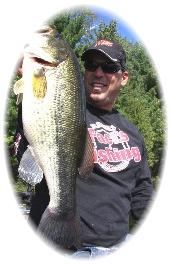|
 Pounding
bottom for Whitefish??? Pounding
bottom for Whitefish???
By
JP DeRose
For the first time in a long time there seems to be a changing of
the guard when it comes to top producing lures when fishing for
Whitefish. For years the jigging style minnow baits and hammered
spoons have ruled the tackle store walls and tackle boxes of ice
fishermen all over Southern and Northern Ontario but if you ice fish
for Whitefish you have probably heard, seen or tried one of the
newer techniques, and it involves pounding bottom! There are a few
different styles of these baits out there but they share a few
things that make them do what they do so well. The Humpback style
baits are designed to be weight forward, have custom paint jobs and
a long slender lead body. These lures are designed to be weight
forward when on the end of a line so they can imitate a bottom
feeing minnow with its tail up. Trailers such as plastic micro
tubes, shad style plastics bodies or grubs are also added to the end
of these baits to entice the fish into striking the bait on the
business end of things… the hook!
Lake Simcoe was the main breeding ground for this lure and the
questions that are frequently asked are: What colors work? How do
you fish it? What tackle should I use? And when is it best to use
it? On Lake Simcoe the best producing colors have been Black Back /
Green Belly, Black Back / Silver Belly and Black Back / Gold Belly.
Any natural minnow patterns also work very well. Trailer colors can
be anything however Blacks, Whites, and Greens are some of my
favorites.
When fishing them, the key is focus; it is not like ripping a big
spoon with 7 hook points on it… the idea is to imitate a bottom
feeding minnow. Let the lure settle on the bottom of the lake then
tighten up on the line so that the lure is still on the bottom but
there is no slack line out. Using a very short jigging motion, lift
the lure from 1 to 4 inches of the bottom letting it pound back into
the bottom on every drop. This will achieve two things... 1. It will
stir up the bottom which will attract fish from quite a distance and
2. It will create sound also bringing the fish in to have a look.
Now depending on the mood of the fish, try to see if they want it
slowly bounced or with a more rapid cadence. Adding in a 5 second
pause while holding it barely off bottom will often produce a very
ferocious strike as well. Remember that the Whitefish will be coming
in from above the lure, so any weight on the lift will be from a
fish that is on top of the bait checking it out. Having a graph or a
flasher will also help in determining the right time to use this
style of lure. If the fish are off bottom and in the mood to chase
then the obvious choice would be a jigging minnow or spoon but when
they are tight to bottom this approach is hard to beat.
Often available in several different sizes from ¼ oz to ¾ oz. they
are best fished with a medium to medium heavy rod that is 18 – 28
inches long. Spinning or Baitcasting reel is up to the individual
however I do recommend 10 lb Fluorocarbon line with a small black
cross lock snap on the lure. The Fluorocarbon line has less stretch
and is virtually invisible under water giving you an advantage when
the fish are finicky and they are studying the bait before
committing, the snap will give the lure more movement and allow it
to tilt further forward. This freedom of movement will assist you in
keeping the head down into the bottom and the hook pointed upwards
and hopefully into the fish’s mouth.
These bottom bouncing baits were designed for winter Whitefish but
have been proven very useful when fishing for Perch, Lake Trout and
Walleye and in open water have excelled for Whitefish and have also
found their way into the mouths of a few smallmouth as well.
Anywhere you can fish vertically, they can be used and be very
effective. Just remember that patience is key and visualizing what
the lure is doing is the key to success.
 
Tight lines and long weekends
JP DeRose
|